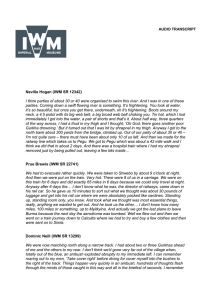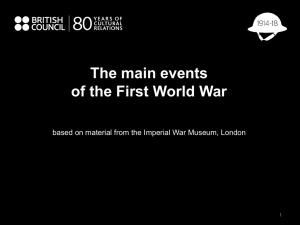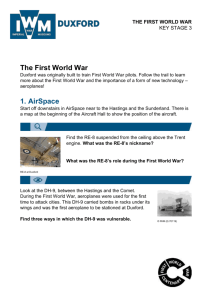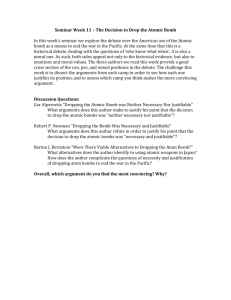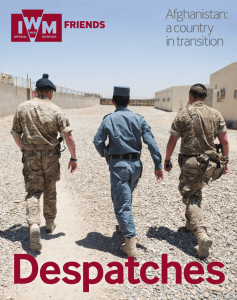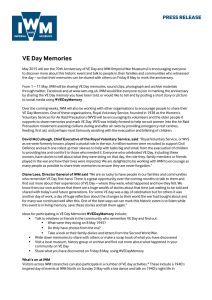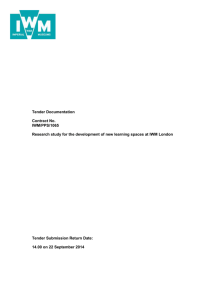Home Front trail - Imperial War Museum
advertisement
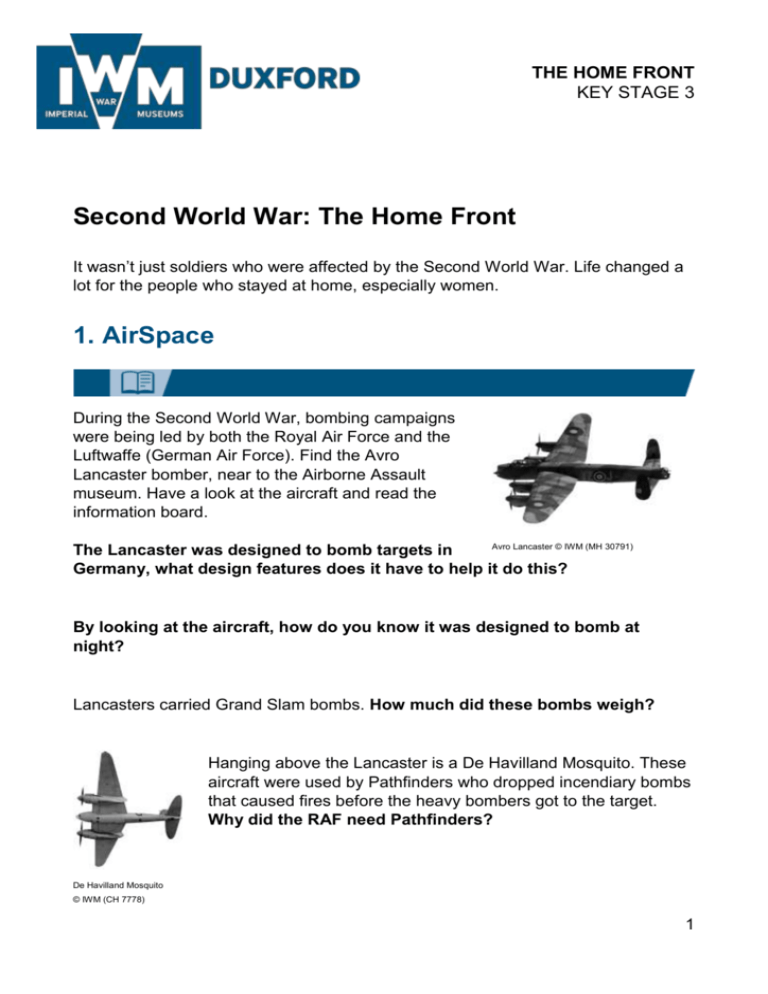
THE HOME FRONT KEY STAGE 3 Second World War: The Home Front It wasn’t just soldiers who were affected by the Second World War. Life changed a lot for the people who stayed at home, especially women. 1. AirSpace During the Second World War, bombing campaigns were being led by both the Royal Air Force and the Luftwaffe (German Air Force). Find the Avro Lancaster bomber, near to the Airborne Assault museum. Have a look at the aircraft and read the information board. Avro Lancaster © IWM (MH 30791) The Lancaster was designed to bomb targets in Germany, what design features does it have to help it do this? By looking at the aircraft, how do you know it was designed to bomb at night? Lancasters carried Grand Slam bombs. How much did these bombs weigh? Hanging above the Lancaster is a De Havilland Mosquito. These aircraft were used by Pathfinders who dropped incendiary bombs that caused fires before the heavy bombers got to the target. Why did the RAF need Pathfinders? De Havilland Mosquito © IWM (CH 7778) 1 2. Hangar 4 (the Battle of Britain) Children were affected by the Second World War. Find the section entitled ‘The Many’, near the Spitfire. How were the lives of children changed by the Second World War? © IWM (D 2591) People who couldn’t fight on the front line took on lots of different roles during the Second World War. They would often do their day job and go straight to a volunteer war job after work. Make a list of examples of war work people did in the Second World War. © IWM (D 4053) To stop the bombers reaching their targets, ground defences were used to help Fighter Command. What ground defences were used in the Second World War? © IWM (Art.IWM PST 14622) Find the true or false cards between the Spitfire and the Anderson shelter. Discuss your answers with your group. Key stage 3: The Home Front 2 Draw a field sketch of the Anderson shelter. Would the Anderson shelter have been effective during an air raid? Find the information boards between the Nash ambulance and the V1 flying bomb. The bombing during the Battle of Britain is known as the Blitz. What it ‘Blitz’ short for? Key stage 3: The Home Front 3 Why were Coventry and Norwich chosen as targets during the Baedeker raids? The name ‘V1’ was a shortened version of Vergeltungwaffe 1. What is this in English? V1 flying bomb © IWM (CL 3433) How many British civilians were killed during the bombing raids? During the Second World War, Germany was also bombed. How many civilians were killed during the raids on Germany? Did you know? To stop V1 flying bombs from reaching their targets, some pilots would fly alongside and use their wings to tip the bomb off course into a field, like the Spitfire pilot in the picture. The first pilot to do this was flying a Gloster Meteor, which you can see in the Cold War area of the hangar. © IWM (CH 16281) The ME 109 after it crash landed in 1940 © IWM (HU During the Second World War, one important job for the people at home was to raise money for the war effort. You could put money into a Spitfire Fund or pay to visit an exhibition of downed German planes. Have a look at the fuselage and tail of the ME 109, which travelled around America. Can you find proof of what happened to the aircraft whilst it was in America? 67701) Key stage 3: The Home Front 4 Teacher’s notes and answer sheet Using the trail We have tried to highlight the areas of the museum which are relevant to your talk and provide activities for the pupils to do there – there is no expectation that any one class or group will complete the whole trail! This trail focuses around Hangar 4, the Battle of Britain and is a 10-15 minute walk from the Visitor Centre. If you would like to visit other hangars or cover topics outside your talk, please feel free to browse our other workshops and trails.You are welcome to use images and ideas from these trails to create your own trail – please keep copyright numbers with images where appropriate. Answers The Lancaster has a large bomb bay and a long range so is designed for bombing. It also has a space for the bomb aimer in the nose, machine gun turrets to fire at fighters and is designed to fly at high altitude. This aircraft is painted to bomb at night as the underside is painted black to match the sky at night and make it harder to fire anti-aircraft guns at. Grand Slam bombs weigh 22, 000lb or 9, 979kg. The RAF needed Pathfinders so the bombers could find their targets during the black out. Children were evacuated from the cities into the countryside, so were taken away from their families possibly for the duration of the war. Represented in this hangar are the Observer Corps and ARP Wardens, however there are also anti-aircraft guns that were operated by the ATS and Home Guard, a balloon winch operated by the Balloon Corps (part of the WAAF), an ambulance operated by the Red Cross and an Alan Williams Turret used by the Home Guard. Pupils can also make suggestions from their own knowledge, for example nurses, fire fighters, joining the Land Army, working in a munitions factory… Ground defences included anti-aircraft guns, searchlights and barrage balloons. Anderson shelters could withstand bomb blasts and protect their occupants from falling debris. They could withstand a direct hit. ‘Blitz’ is short for Blitzkrieg, the German phrase meaning ‘lightning war’. Cities that were bombed in the Baedeker raids had received a three star rating or more in the Baedeker guide book. Vergeltungwaffe means ‘reprisal weapon’ or ‘revenge weapon’ in English. 60, 000 British and 750, 000 German civilians were killed in bombing raids. The ME 109 has people’s names scratched into the rear of the fuselage. Key stage 3: The Home Front 5
